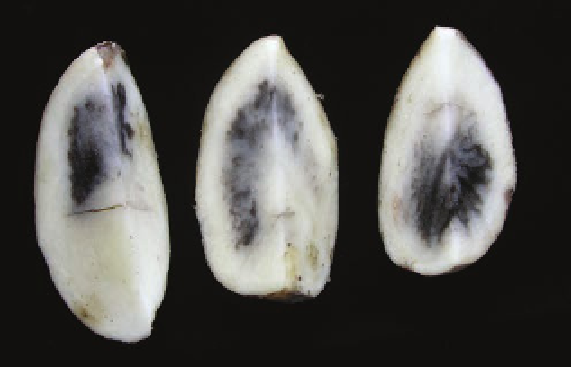Agriculture Reference
In-Depth Information
Fig. 14.5.
Blackheart. (Photo courtesy of K.I. Al-Mughrabi, New Brunswick Department of Agriculture,
Aquaculture and Fisheries.)
from affected tubers is dark and the other end is
light. Certain cultivars, especially those with
long-type tubers like Russet Burbank, tend to be
more prone to translucent end, and it is often as-
sociated with tubers exhibiting second growth or
pointed stem ends (Hiller and Thornton, 1993).
When translucent end tissue becomes soft
and jelly-like, it is referred to as jelly end. A con-
dition called jelly end rot develops when jelly end
tuber tissues break down and collapse in storage
(Iritani and Weller, 1973). There is a distinct line
between the affected and healthy tissues (Thorn-
ton, 2001b). The rot does not usually spread in
storage (Hodgson
et al
., 1974).
Moisture stress and heat stress during tuber
initiation and early tuber bulking result in trans-
lucent end (Iritani and Weller, 1973; Kleinkopf
et al
., 1988; Shock
et al
., 1993). Shock
et al
.
(1993) found that a single transitory water def-
icit was sufficient to induce translucent end.
They also found that reducing sugar content of
the stem end of the affected tubers did not in-
crease during or just after the moisture stress,
but several weeks later. When stressed, imma-
ture tubers and tubers stored at low temperat-
ures (5°C) immediately following harvest are
more prone to translucent end (Iritani and
Weller, 1973, 1978). Inadequate fertility that
leads to premature vine death has been associ-
ated with high reducing sugars in the stem ends
of tubers (Iritani and Weller, 1978).
Sugar accumulation in translucent end tis-
sue is due to stress-induced alteration of the
enzymes responsible for sucrose and starch
metabolism. Geigenberger
et al
. (1997) demon-
strated that, with moderate water stress, sucrose
phosphate synthase, the enzyme responsible
for sucrose synthesis, was activated in intact
tubers. With more extreme water stress, they
also found inhibition of the enzymes involved
in the terminal reactions of starch synthesis.
Sowokinos
et al
. (2000) compared enzyme ac-
tivity in translucent end and normal tissues. In
translucent end tissue, compared with normal
tissue, adenosine diphosphate (ADP)-glucose
pyrophosphorylase and uridine diphosphate
(UDP)-glucose pyrophosphorylase activity
were decreased and starch phosphorylase
activity was increased, all indicative of starch
mobilization. In addition, activity of acid in-
vertase, the vacuolar enzyme that breaks down
sucrose into glucose and fructose, was twice as
high in translucent end tissue as in normal tis-
sue mid-growing season, and four times as
high after several months in storage. Increased
inorganic phosphate (Pi) (Sowokinos
et al
.,
2000) and decreased pH (Iritani and Weller,
1973; Sowokinos
et al
., 2000) are also charac-
teristic of translucent end tissues. In translu-
cent end tubers, there is a shift in carbohydrate
metabolism away from starch synthesis and
toward the accumulation of reducing sugars.
A recent review by Thompson
et al
. (2008) re-
vealed that, once translucent end was trig-
gered, reducing sugar accumulation could not
be reversed.

